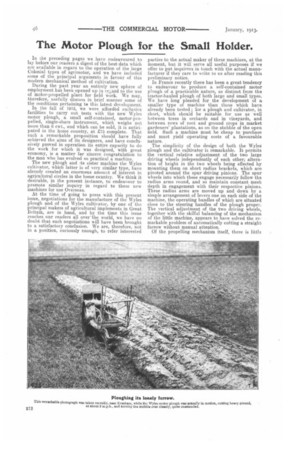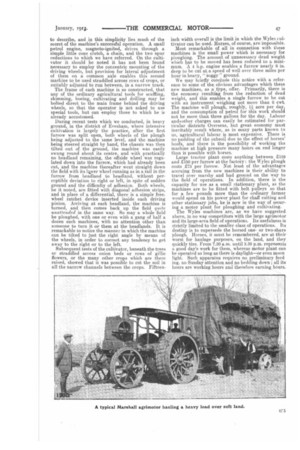The Motor Plough for the Small Holder.
Page 68

Page 69

If you've noticed an error in this article please click here to report it so we can fix it.
In the preceding pages we have endeavoured to lay before our readers a digest of the best data which are available in regarci to the operation of the large Colonial types of agrimotor, and we have included some of the principal alguments in favour of this modern Mechanical method of cultivation.
During the past year an entirely new sphere of employment has beeu opened up in r,eard to the use of motor-propelled plant for held work. We may, therefore, usefully discuss in brief manner some of the conditions pertaining te this latest development. In the fall of 1912, we were afforded enclusive facilities to carry out tests with the new Wyles motor plough, a small self-contained, motor-propelled, single-share instrument, which weighs not more than 6 cwt., and which can be sold, it is anticipated in the home country, at 275 complete. That such a remarkable proposition should have fully achieved the aims of its 'designers, and have conclusively proved in operation its entire capacity to do the work for which it was designed, with great economy, is a matter for sincere cengratulation to the man who has evolved so practical a machine. The new plough and 'ts sister machine the Wyles cultivator, which latter is of very similar type, have already created an enormous amount of interest in agricultural circles in the home ceuntry. We think it desirable, in the present instance, to endeavour to prsmote similar inquiry in regard to these new machines for use Overseas.
At the time of going to press with this present issue, negotiations for the manufacture of the Wyles plough and of the Wyles cultivator, by one of the principal makers of agricultural implements in Great Britain, are in hand, and by the time this issue reaches our readers all over'the world, we have no doubt that such negotiations will have been brought, to a satisfactory conclusion. We are, therefore, not in a position, curiously enough, to refer interested parties to the actual maker of these machines, at the moment, but it will serve all useful purposes if we offer to put inquirers in touch with the actual manufacturer if they care to write to us after reading this preliminary notice.
In France recently there has been a great tendency to endeavour to produce a self-contained motor plough of a practicable nature, as distinct bon the tractor-hauled plough of both large and small types. We have long pleaded for the development of a smaller type of machine than those which have. already been tested; for a plough and cultivator, in short, which should be suitable for use as well between trees in orchards and in vineyards, and between rows of root and ground crops in market gardeners' plantations, as on the stubble of the open field. Such a machine must be cheap to purchase and must yield operating costs of a favourable nature.
The simplicity of the design of both the Wyles plough and the cultivator is remarkable. It permits the vertical relative adjustment of the two large driving wheels independently of each other; alteration of height in the two wheels being effected by mounting them on short radius brackets, which are pivoted around the spur driving pinions. The spur wheels into which these engage necessarily follow the radius arms round, and so maintain constant mesh depth in engagement with their respective pinions. These radius arms are moved up and down by a simple arrangement of levers one on each side of the machine, the operating handles of which are situated close to the steering handles of the plough proper. The vertical adjustment of the two driving wheels, together with the skilful balancing of the mechanism of the little machine, appears to have solved the remarkable problem of automatically cutting a straight furrow without manual attention.
Of the propelling mechanism itself, there is little to describe, and in this simplicity lies much of the secret of the machine's successful operation. A small petrol engine, magneto-ignited, drives through a simple little cone elutch, a chain, and the two spur reductions to which we have referred. On the cultivator it should be noted it has not been found necessary to employ the concentric mounting of the driving wheels, but provision for lateral adjustment of them on a common axle enables this second machine to be used straddled across rows of crops, or suitably adjusted to run between, in a narrow track.
The frame of each machine is so constructed, that any of the ordinary agricultural tools for scuffling, skimming, hoeing, cultivating and drilling may be halted direct to the main frame behind the driving wheels, so that the operator is net asked to use special tools, but can employ those to which he is already accustomed.
During recent tests which we conducted, in heavy ground, in the district of Evesham, where intensive cultivation is largely the practice, after the first furrow was split open, both wheels of the plough being adjusted to the same level, and the machine being steered straight by hand, the chassis was then tilted out of the ground, the machine was easily swung round about its centre, and with practically no headland remaining, the offside wheel was regulated down into the furrow, Which had already been cut, and the machine thereafter went straight down the field with its lqgver wheel running as in a rail in the furrow from headland to headland, without perceptible deviation to right or left, in spite of sodden ground and the difficulty of adhesion. Both wheels, be it noted, are fitted with diagonal adhesion strips, and in place of a differential, there is a simple free, wheel ratchet device inserted inside each driving pinion. Arriving at each headland, the machine is turned, and then comes back up the field qtriteunat,encled in the same way. So may a: whole field be ploughed, with one or even with a gang of half a dozen such machines, with no attention other than someone to turn it or them at the headlands. It is remarkable to notice the manner in which the machine can be tilted to just the right angle by means of the wheels, in order to correct any tendency to get away to the right or to the left. Subsequent tests of the cultivator, beneath the trees or straddled across onion beds or rows of gillie flowers, or the many other crops which are there raised, showed that it was possible to cut the soil in all the narrew channels between the crops. Fifteen
inch width overall is the limit in which the Wylescultivator can be used. Horses, of course, are impossible. Most remarkable of all in connection with these machines is the small power which is necessary for ploughing. The amount of unnecessary dead weight which has to be moved has been reduced to a minimum. A 4 h.p. engine enables a furrow nearly 6 in. deep to be cut at a speed of well over three miles per hour in heavy, " Soggy " ground.
We may briefly conclude this notice with a reference to some of the, obvious advantages which these new machines, as agkpe, offer. Primarily., there is the economy resulting from the reduction of dead weight, and this enables a single furrow to be cut with an instrument weighing not more than 6 cwt. The machine will plough, roughly, q acre per day, and the consumption of petrol for this work should not be more than three gallons for the day. Labour androther charges can easily be estimated for partieular districts Overseas, but great economy must inevitably result where, as in many parts known to us, agricultural labour is most expensive. There is no padding of the subsoil due to the effect of horses' hoofs, and there is the possibility of working the machine at high pressure many hours on end longer than is possible with horses. Large tractor plant costs anything between 2100 and £150 per furrow at the factory the Wyles plough costs 275 per furrow. Not least of the advantages accruing from the new machines is their ability to travel over marshy and bad ground on the way to the field of operations. In addition, there is the capacity for use as a small stationary plant; as the machines are to be fitted with belt pulleys so that for a few pounds more than the ordinary farmer would spend on his power plant for chaff cutting and other stationary jobs, he is now in the way of ecurmg a motor plant for ploughing and cultivating. The Wyles machines are as we have suggested above, in no way competitors with the large agrimotor and its large-area field of operations. Its usefulness is strictly limited to the smaller class of operations. Its destiny is to supersede the horsed oneor two-share plough. Horses, it must be remembered, are at their worst for haulage purposes, on the land, and they quickly tire. From 7.30 a.m. until 3.20 p.m. represesots a. good day's work for them, whereas motor plant can be operated so long as there is daylight—or even moon light. Such apparatus requires no preliminary feed ing, no Sunday attention and no bedding down ; all its hours are working hours and therefore earning hours.


























































































